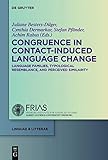Congruence in Contact-Induced Language Change : Language Families, Typological Resemblance, and Perceived Similarity.
Material type: TextSeries: Linguae & litteraeCopyright date: ©2014Description: 1 online resource (420 pages)Content type:
TextSeries: Linguae & litteraeCopyright date: ©2014Description: 1 online resource (420 pages)Content type: - text
- computer
- online resource
- 9783110338454
- 3110338459
- 3110338343
- 9783110338348
- 3110338467
- 9783110338461
- 9781306430395
- 1306430399
- Languages in contact
- Language and languages -- Variation
- Typology (Linguistics)
- Langues en contact
- Variation (Linguistique)
- Typologie (Linguistique)
- POLITICAL SCIENCE -- Public Policy -- Cultural Policy
- SOCIAL SCIENCE -- Anthropology -- Cultural
- SOCIAL SCIENCE -- Popular Culture
- Language and languages -- Variation
- Languages in contact
- Typology (Linguistics)
- Kontrastive Linguistik
- Arealtypologie
- Kongruenz
- Slawische Sprachen
- Romanische Sprachen
- Sprachkontakt
- Sprachwandel
- 306.44
- P130.5 .C656 2014
- KD 1560
| Item type | Home library | Collection | Call number | Materials specified | Status | Date due | Barcode | |
|---|---|---|---|---|---|---|---|---|
 Electronic-Books
Electronic-Books
|
OPJGU Sonepat- Campus | E-Books EBSCO | Available |
Print version record.
Introduction; Part 1: Contact-induced change between closely related languages; Convergence in the Baltic-Slavic contact zone: Triangulation approach; Convergence and congruence due to contact between the South Slavic languages; The case of Czech-Slovak language contact and contact-induced phenomena; Belarusian and Russian in the Mixed Speech of Belarus; Lingua Franca in the Western Mediterranean: between myth and reality; Intimate family reunions: code-copying between Turkic relatives; Part 2: Contact-induced changes in scenarios with looser family ties.
Language contact in a multilingual setting: The attractive force of Italo-romance dialects on Italian in MontrealBalkan Slavic and Balkan Romance: from congruence to convergence; The convergence of Czech and German between the years 900 and 1500; Part 3: Typological congruence and perceived similarity; Contact-induced language change and typological congruence; Similarity effects in language contact: Taking the speakers' perceptions of congruence seriously; Doing copying: Why typology doesn't matter to language speakers.
South Siberian Turkic languages in linguistic contact: Altay-kiži nominalizer constructions as a test caseFrench meets Arabic in Cairo: discourse markers as gestures; Language mixing and language fusion: when bilingual talk becomes monolingual; Part 4: "Doing being family": language families and language ideologies; Siblings in contact: the interaction of Church Slavonic and Russian; Transparency of morphological structures as a feature of language contact among closely related languages: Examples from Bulgarian and Czech contact with Russian.
Avoiding typological affinity: "negative borrowing" as a strategy of Corsican norm findingSociolinguistic and areal factors promoting or inhibiting convergence within language families.
Modern contact linguistics has primarily focused on contact between languages that are genetically unrelated and structurally distant. This compendium of articles looks instead at the effects of pre-existing structural congruency between the affected languages at the time of their initial contact, using the Romance and Slavic languages as examples. In contact of this kind, both genetic and typological similarities play a part.
Includes bibliographical references.
English.
eBooks on EBSCOhost EBSCO eBook Subscription Academic Collection - Worldwide
There are no comments on this title.

